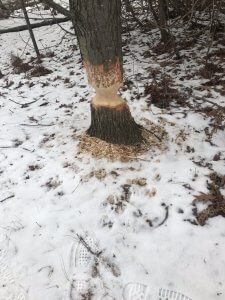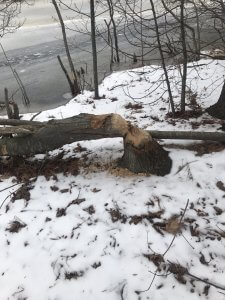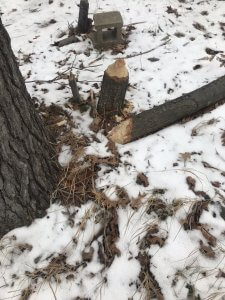

Property damage caused by beavers at a northern Michigan client’s home.
In recent years, beaver populations have been relatively high. This is due to a lack of extensive trapping and an abundance of food. These animals can cause considerable problems for county road commissions, private landowners, and waterfront landowners. They create these problems by tree cutting, building dams, flooding property, and blocking culverts. We most often receive calls from property owners experiencing issues due to beaver damage of trees and flooding of waterways, which interferes with land uses. This can cause devastating structural and landscaping damage if untreated.
Beaver Trapping and Removal
Beaver are especially aggressive in the late summer and fall, but do not hibernate in the winter months so a problem may persist. There is one overwhelming fact of dealing with them – you must remove all of the beaver to solve the problem. Any attempt to control these problems without removing the beaver is futile. It is possible to unplug a culvert and draw the water down with them still in place; however, in most cases, the dam will be rebuilt, and the water will flood the next day again.
Ideally, if the problems are not too extreme, an experienced trapper can remove all the beaver in the area during the licensed trapping season. Unfortunately, beaver problems often crop up well before the late fall trapping season. If the problem is pressing, a free Beaver Damage Control Permit can be obtained from the DNR. This allows the landowner to remove the beaver outside of the trapping season if there is proven damage (road washout, flooding, etc.).
Catching these animals during the offseason is more difficult; this is due to their behavior being somewhat different from what many trappers most commonly deal with. Inexperienced trappers will often create more of a problem for you in the long run. They can sometimes only catch one or two of the young beaver; this results in the rest of the colony with adults becoming much warier.
Removal Mistakes
A common mistake we hear of is landowners stating their intention to remove the beaver by shooting them. Research indicates the average colony is about five animals. Anyone trying to shoot all the beaver in a colony one time will quickly find that is impossible. The most likely scenario is that one or two of the young may be vulnerable to shooting; the rest of the colony will become completely nocturnal. Shooting these animals is not easy since there is very little visible when they are swimming. Shooting should only be a last resort for wildlife professionals.
In years past, conservation officers and fire officers would blast beaver dams out with dynamite. Times have changed, and dams are not blasted anymore. Another danger of blasting the dams is the likelihood of washing out downstream roads, culverts, and stream crossings. When a large dam (some up over six feet high) is suddenly breached, a large head of water rushes downstream. Anyone who intends to breach a beaver dam should keep in mind that it can do considerable damage downstream; it is important to scout out any potential crossings downstream ahead of time. The danger of washout is even greater if there is a significant gradient downstream.
Successful Removal
As stated, if downstream stream crossings are a concern for removing a large head of water, the dam can typically be removed gradually. The best practice is to remove a section of the upper portion of the dam and then let the water flow out down to the level cleared overnight. The next day another part of the dam can be removed, which allows the entire impoundment of water behind the dam to drain more gradually, hopefully avoiding any downstream water damage. If the impoundment behind the dam is vast, greater care needs to be taken breaching the dam. When removing a large dam, great care should be taken only to remove just enough of the dam. This will relieve some of the water pressure over several days.
One thing to remember is the easiest way to minimize beaver problems in Northern Michigan is not to create an ideal habitat next to stream crossings. Of course, beaver are in the rodent family, and they are incredibly prolific. If a suitable food habitat is present near water, landowners will likely have decades of reoccurring problems. The only long-term solution to minimize beaver problems outside of trapping is converting nearshore stream habitat to conifer that beaver don’t utilize for food.
We specialize in the trapping and removal of these animals, so call us to set up an inspection today!
